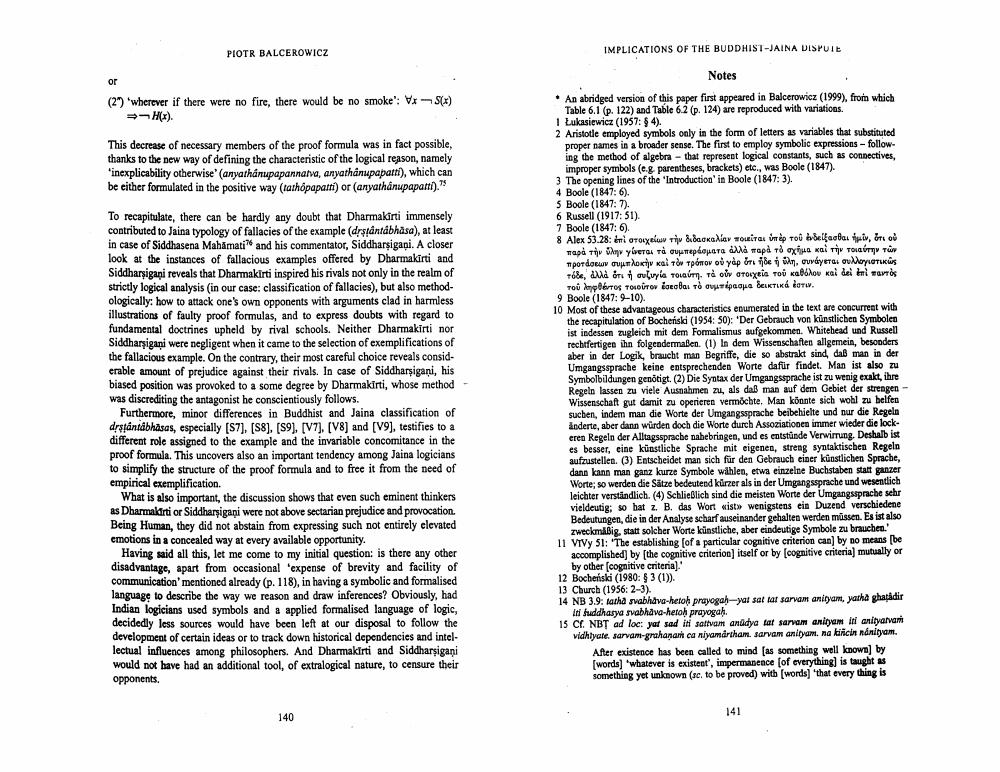________________
PIOTR BALCEROWICZ
IMPLICATIONS OF THE BUDDHIST-JAINA DISPUTE
(27) 'wherever if there were no fire, there would be no smoke": VES(x)
HI)
This decrease of necessary members of the proof formula was in fact possible, thanks to the new way of defining the characteristic of the logical reason, namely 'inexplicability otherwise' (anyathanupapannatva, anyathinupapart), which can be either formulated in the positive way (tarhópapatti) or (anyathanupaparti)."
To recapitulate, there can be hardly any doubt that Dharmakarti immensely contributed to Jaina typology of fallacies of the example (drstantábhasa), at least in case of Siddhasena Mahamati and his commentator, Siddharsigani. A closer look at the instances of fallacious examples offered by Dharmakirti and Siddharşigani reveals that Dharmakirti inspired his rivals not only in the realm of strictly logical analysis (in our case: classification of fallacies), but also method ologically: how to attack one's own opponents with arguments clad in harmless illustrations of faulty proof formulas, and to express doubts with regard to fundamental doctrines upheld by rival schools. Neither Dharmakirti nor Siddharsigani were negligent when it came to the selection of exemplifications of the fallacious example. On the contrary, their most careful choice reveals considerable amount of prejudice against their rivals. In case of Siddharsigani, his biased position was provoked to a some degree by Dharmakirti, whose method was discrediting the antagonist he conscientiously follows.
Furthermore, minor differences in Buddhist and Jaina classification of drstántábhasas, especially (S7). [58]. [S9). [V7), (V8] and [V9), testifies to a different role assigned to the example and the invariable concomitance in the proof formula. This uncovers also an important tendency among Jaina logicians to simplify the structure of the proof formula and to free it from the need of empirical exemplification.
What is also important, the discussion shows that even such eminent thinkers as Dharmalarti or Siddharsigani were not above sectarian prejudice and provocation. Being Human, they did not abstain from expressing such not entirely elevated emotions in a concealed way at every available opportunity.
Having said all this, let me come to my initial question is there any other disadvantage, apart from occasional expense of brevity and facility of communication' mentioned already (p. 118), in having a symbolic and formalised language to describe the way we reason and draw inferences? Obviously, had Indian logicians used symbols and a applied formalised language of logic, decidedly less sources would have been left at our disposal to follow the development of certain ideas or to track down historical dependencies and intellectual influences among philosophers. And Dharmakirti and Siddharsigani would not have had an additional tool, of extralogical nature, to censure their opponents.
Notes • An abridged version of this paper first appeared in Balcerowicz (1999), from which
Table 6.1 (p. 122) and Table 6.2 (p. 124) are reproduced with variations. 1 Lukasiewicz (1957: $ 4). 2 Aristotle employed symbols only in the form of letters as variables that substituted
proper names in a broader sense. The first to employ symbolic expressions - follow. ing the method of algebra - that represent logical constants, such as connectives,
improper symbols (eg parentheses, brackets) etc., was Boole (1847). 3 The opening lines of the "Introduction in Boole (1847:3). 4 Boole (1847:6). 5 Boole (1847:7) 6 Russell (1917: 51). 7 Boole (1847:6). 8 Alex 53.28: en royco Tibexde soires in ip robbelfasta , ono
παρά την ύλην γίνεται τα συμπεράσματα αλλά παρά το σχήμα και την τοιαύτην τών προτάσεων συμπλοκής και τον τρόπον ου γαρ ότι ηδε ή ύλη, συνάγεται συλλογιστικώς τόξο, αλλά ότι η συζυγία τοιαύτη, τα ούν στοιχεία του καθόλου και αεί επί παντός του ληφθέντος τοιούτον έσεσθαι το συμπέρασμα δεικτικά εστιν. 9 Boole (1847: 9-10). 10 Most of these advantageous characteristics enumerated in the text are concurrent with
the recapitulation of Bocheńska (1954: 50): "Der Gebrauch von künstlichen Symbolen ist indessen zugleich mit dem Formalismus aufgekommen. Whitehead und Russell rechtfertigen ihn folgendermaßen (1) In dem Wissenschaften allgemein, besonders aber in der Logik, braucht man Begriffe, die so abstrakt sind, daß man in der Umgangssprache keine entsprechenden Worte dafür findet. Man ist also zu Symbolbildungen genotigt. (2) Die Syntax der Umgangssprache ist zu wenig exakt, ihre Regeln lassen zu viele Ausnahmen zu, als daß man auf dem Gebiet der strengen Wissenschaft gut damit zu operieren vermöchte. Man könnte sich wohl zu belfen suchen, indem man die Worte der Umgangssprache beibehielte und nur die Regeln Anderte, aber dann würden doch die Worte durch Assoziationen immer wieder die lockeren Regeln der Alltagssprache nahebringen, und es entstünde Verwirrung. Deshalb ist es besser, eine künstliche Sprache mit eigenen, streng syntaktischen Regeln aufzustellen. (3) Entscheidet man sich für den Gebrauch einer künstlichen Sprache, dann kann man ganz kurze Symbole withlen, etwa einzelne Buchstaben statt ganzer Worte; so werden die Sätze bedeutend kürzer als in der Umgangssprache und wesentlich leichter verständlich. (4) Schlieblich sind die meisten Worte der Umgangssprache schr vieldeutig: so hat z. B. das Wort wist wenigstens ein Duzend verschiedene Bedeutungen, die in der Analyse scharf auseinander gehalten werden müssen. Es ist also
Zweckmdißig, statt solcher Worte künstliche, aber eindeutige Symbole zu brauchen. 11 VIVy 51: "The establishing (of a particular cognitive criterion cas) by no means [be
accomplished by the cognitive criterion) itself or by (cognitive criteria) mutually or
by other cognitive criteria)." 12 Bocheński (1980: $3 (1)). 13 Church (1956:2-3). 14 NB 3.9. tatha svabhava-hetoh prayogah-yal sattar sarvam aniyam, yarha ghaddir
Idi fuddhasya sabhava hetoh prayogah. 15 Cf. NBT ad loc: yor sad iti sattvam anüdya at sarvam anityam iti antyalvari vidhtyate. sarvam-grahanart ca niyamartham sarvam anityam, na karcin Raaltyam.
After existence has been called to mind as something well known by (words] 'whatever is existent, impermanence (of everything) is taught as something yet unknown (sc. to be proved) with (words) that everything is
140
141




